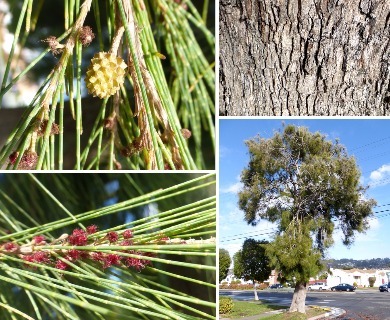Australian Pine
Casuarina equisetifolia
Australian Pine family (Casuarinaceae)
Post-Cook introduction
Horsetail casuarina is the species most commonly planted in Hawaii and in other tropical and subtropical regions around the world, where it has become naturalized. A rapidly growing medium to large tree becoming 50–100 ft (15–30 ) tall and 1–1 1⁄2 ft (0.3–0.5 ) in trunk diameter, with a thin of drooping twigs. The bark is light gray brown, smoothish on small trunks, becoming rough, thick, furrowed and shaggy, and splitting into thin strips and flakes exposing a reddish brown layer. Inner bark is reddish and bitter or astringent. The wiry drooping twigs, mostly 9–15 inches (23–38 ) long, are dark green, becoming paler, with 6–8 long fine lines or ridges ending in leaves, shedding gradually like pine needles. A few main twigs, gray and finely hairy, become rough and stout and develop into brownish branches.

©2015 Zoya Akulova
Flower clusters inconspicuous, light brown, male and female on the same tree (). Male flower clusters (like spikes or ) are narrowly cylindrical, 3⁄8–3⁄4 inch (10–19 ) long and as much as 1⁄8 inch (3 ) across. minute and crowded in rings among grayish consist of one protruding brownish less than 1⁄8 inch (3 ) long with two minute brown at base. Female flower clusters are short-stalked lateral balls (heads) less than 1⁄8 inch (3 ) in diameter or 5⁄16 inch (8 ) across spreading consisting of 3⁄16 inch (5 ) long including small and long threadlike dark red
The multiple is a light brown hard warty ball 1⁄2–3⁄4 inch (13–19 ) in diameter, often longer than broad and slightly cylindrical, composed of points less than 1⁄8 inch (3 ) long and broad, each from a flower. An individual splits open in two parts at maturity to release one winged light brown seed (nutlet) 1⁄4 inch (6 ) long.
The sapwood is pinkish to light brown, the heartwood dark brown. The fine-textured wood is very hard, heavy ( gr. 0.81), and very susceptible to attack by dry-wood termites. Tests of the wood have been made in Puerto Rico. It is strong, tough, difficult to saw, but cracks and splits, and is not durable in the ground. Rate of air-seasoning is moderate, and the amount of degradation is considerable. Machining characteristics are as follows: planing and turning are fair; and shaping, boring, mortising, sanding, and resistance to screw splitting are good. In Hawaii, this wood is used only as fuel. Elsewhere, the wood is used in the round. Uses include fence posts and poles, beams (not underground), oxcart tongues, and charcoal. The bark has been employed in tanning, in medicine, and in the extraction of a red or blue-black dye. In southern Florida, the have been made into novelties and Christmas decorations. Often propagated by cuttings for street, park, ornamental, and windbreak plantings, it can also be trimmed into hedges. It is used for reforestation because of its rapid growth and adaptability to degraded sites.
This tree grows rapidly, reportedly as much as 80 ft (24 ) in height in 10 years, and adapts to sandy seacoasts, where it becomes naturalized. It is very salt tolerant.
Common and naturalized along sandy coasts of Hawaii and up to more than 3000 ft (914 ). It is used as windbreaks, such as along the Kohala Mountain Road, Hawaii; at Waimanalo, Oahu; and Hanalei, Kauai, near the pier. More than 70,000 trees were planted on the Forest Reserves and many others on private lands. The species was successfully established on severely eroded Kahoolawe where it was to be a windbreak for other tree species. However, goats broke through a fence and ate all the trees. The same system was used in the 1890’s to plant the extremely windy Nuuanu Valley near the Pali.
Special areas
Waimea Arboretum, Kalopa
Champion
Height 89 ft (27.2 ), c.b.h. 17.3 ft (5.3 ), spread 56 ft (17.1 ). Olowalu, Maui (1968).
Range
Native of tropical Asia and Australasia but planted and naturalized in various tropical and subtropical regions. Planted and naturalized in southern Florida and Puerto Rico and Virgin Islands.
Other common names
“shortleaf ironwood”, “common ironwood” (Hawaii); “Australian-pine”, beefwood, she-oak, toa; pino australiano, pino de Australia (Puerto Rico, Spanish).




